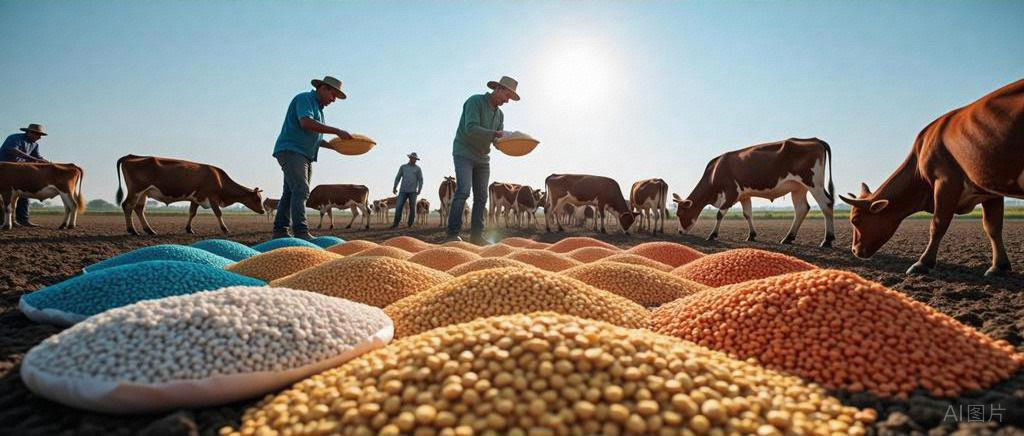The benefits of developing anti-free feed to farmers
Release time:
2025-08-02
Developing antibiotic-free feed brings significant and multifaceted benefits to farmers, not only improving current farming efficiency but also focusing on the long-term development of the industry and market demands. These benefits are specifically reflected in the following aspects:

Developing antibiotic-free feed brings significant and multifaceted benefits to farmers, not only improving current farming efficiency but also focusing on the long-term development of the industry and market demands. These benefits are specifically reflected in the following aspects:
Enhancing the Health of Farm Animals
Optimizing the Gut Microbiota: Antibiotic-free feed often includes probiotics, prebiotics, and other beneficial components. These helpful microorganisms multiply extensively in the animals’ intestines, helping to suppress the growth of harmful bacteria and maintain a balanced gut microbiome. For example, in piglet farming, the use of antibiotic-free feed can noticeably reduce the population of harmful bacteria such as E. coli, lowering the incidence of intestinal diseases like diarrhea and improving piglet survival rates and growth performance.
Boosting Immune Function: Some antibiotic-free feeds contain plant extracts, immune polysaccharides, and other substances that can stimulate the animals’ immune systems, enhancing their natural immunity and resistance. In poultry farming, for instance, chicken flocks that consume antibiotic-free feed over the long term demonstrate stronger resistance when faced with common viral threats such as avian influenza and Newcastle disease, resulting in a reduced risk of infection.
Improving the Quality of Farm Products
Reducing Drug Residues: Antibiotic-free feed avoids the addition of antibiotics, eliminating the source of antibiotic residues in animals. As a result, meat, eggs, milk, and other products produced by farmers using such feed no longer contain antibiotic residues. This meets the growing consumer demand for green and safe food, allowing these products to gain higher market recognition and pricing advantages. For example, antibiotic-free pork—characterized by the absence of antibiotic residues and superior taste—often commands significantly higher prices in premium markets compared to conventional pork.
Enhancing Product Flavor: Some antibiotic-free feeds, through scientifically formulated recipes and the selection of high-quality raw materials, can improve the flavor of farm products. For instance, fish fed with specific antibiotic-free feed exhibit reduced fishy odors and more delicious taste, making them more popular in the market. This helps farmers achieve higher selling prices and profit margins.
Aligning with Policy and Market Trends
Meeting Policy Requirements: As global attention to food safety and environmental protection continues to grow, more and more countries and regions have introduced “antibiotic-free” policies for feed. By using antibiotic-free feed, farmers can ensure that their operations comply with regulatory requirements, avoid the risks of penalties associated with non-compliant antibiotic use, and maintain the legality and stability of their production activities.
Adapting to Market Demand: The pursuit of healthy and safe food by consumers is driving increasing demand for antibiotic-free farming products in the market. By actively adopting antibiotic-free feed and producing such products, farmers can better meet market needs, expand sales channels, and enhance product competitiveness. Large supermarkets, e-commerce platforms, and other major buyers are showing growing demand for antibiotic-free products, offering farmers more opportunities to collaborate with high-quality clients through these offerings.
Long-Term Cost-Benefit Advantages
Reducing Medication Expenditures: With the improved health of animals and lower incidence of disease, farmers using antibiotic-free feed will see a significant reduction in medication costs for treating animal illnesses. For large-scale farming operations, this represents substantial cost savings. For example, a pig farm with a herd of 1,000 pigs can save tens of thousands of yuan annually on treatment medications after switching to antibiotic-free feed.
Improving Farming Efficiency: Healthier animals exhibit more stable growth rates and higher feed conversion efficiency. Antibiotic-free feed helps enhance animal growth performance, enabling them to reach market weight standards more quickly and shortening the overall farming cycle. In pig farming, for example, pigs raised on antibiotic-free feed may reach market weight 1–2 weeks earlier than those raised on traditional antibiotic-containing feed. This means farmers can achieve more production cycles within the same timeframe, improving both efficiency and economic returns.
Tag:
Recommended
Share


